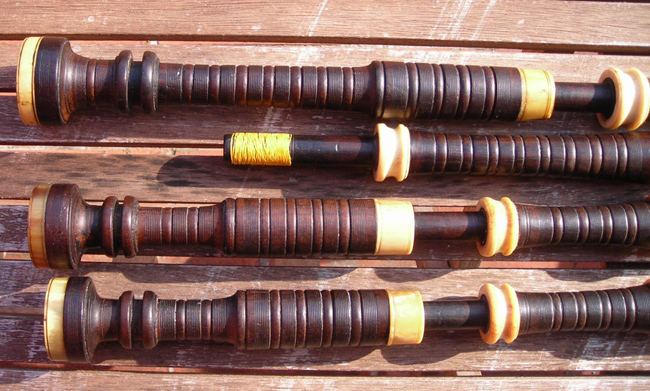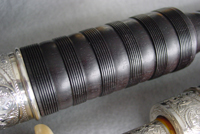Enjoying the pleasures of pipes past
pipes were made in ebony and cocuswood. Clearly, instrument makers even in the early 1900s, when cocuswood and ebony were still readily available, preferred the more trouble-free African blackwood.
Pipes were not restricted entirely to the woods described above. Other woods such as cocobolo and rosewood have been in regular use. Lignum vitae entered the British Isles in the 1800s as ballast in empty ships returning from the west Indies. Woodworkers could haul it away from the docks at will. During the late 1800s and early 1900s, as wood choices changed, it was not unusual for pipes to be made with a mix of ebony and blackwood, perhaps even with a cocuswood or cocobolo piece appearing here and there. Brazilian Kingwood also pops up early on.

Some early makers used less expensive indigenous woods of the British Isles. John Cameron was one of these. He lived in Dundee and made pipes through the early and mid-1800s. They come to light now and then, but his simple design and the lightweight laburnum or fruitwood he used might lead an uneducated piper who found a set to think they were Pakistani or some hobbyist’s project. Tonally they are not special, but Cameron’s existing sets – some of which were stamped with “J. Cameron, Dundee” – are great examples of lower-end pipes being made for common people or the military in the early nineteenth century. While considered a second-rate musical wood, laburnum is very resilient, and some laburnum sets from the early 1800s remain free of cracks to this day.

Identifying the wood used in old pipes is not always easy. Many look similar, particularly under a coat of varnish. Identity is best made when pipes are being restored or refinished. Ebony can often often be distinguished from blackwood by distinctive surface markings. Ebony may be peppered with tiny flecks or chips due to its brittle nature, and it frequently shows short, shallow lines that can be mistaken for cracks where the grain has opened slightly.
There are many different kinds of ebony (often identified by where it originated, like ‘Gabon ebony’), but the best ebony is a pure, deep black with almost no grain colour visible to the naked eye. Unfortunately, crack-free ebony pipes are becoming increasingly rare.

I’m surprised there are not a number of comments or questions on this article – a lot of information, experience and work in the article, much of which was new to me. So glad the article was retrieved!